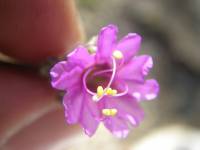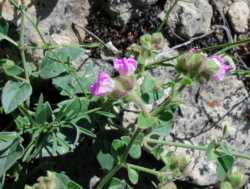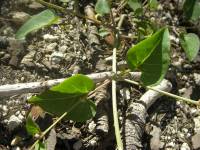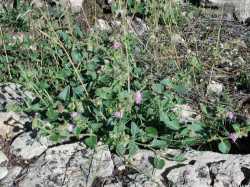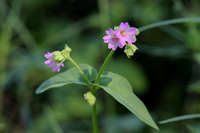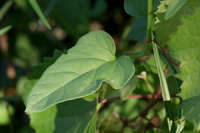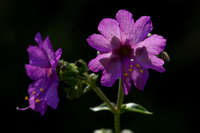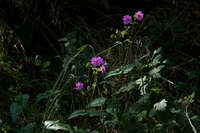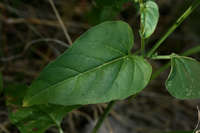Stems 1 -many, erect to decumbent, few or highly branched, sparsely to densely leafy in basal 1/2 or throughout, 0.8-15 dm, glabrous to puberulent basally in 2 lines or throughout, hairs often awned, or stems villous and often viscid, or sometimes hirsute, hair types often mixed, spreading pubescent. Leaves ascending to spreading at 10-90°; petiole 0-4 cm; blade green to glaucous blue-gray, linear-lanceolate to ovate-lanceolate, ovate, or deltate, 1-11 × 0.6-2.5 cm in lanceolate leaves, 2-9 × 1-6.5 cm in ovate leaves, thin and fleshy to thick and coriaceous, base cuneate to round, truncate, or cordate, apex acute, obtuse, or round, surfaces glabrous or viscid-puberulent, viscid-villous, or hirsute. Inflorescences axillary or terminal, few branched, ± evenly forked and open, or, when axillary, often consisting only of single involucres (and then flowers commonly cleistogamous); peduncle 1-25 mm, puberulent with curled hairs, hispid, villous, or viscid-villous, crosswalls of hairs pale; involucres pale green or sometimes blushed with purple when young, widely bell-shaped, 4-7 mm in flower, 5-15 mm in fruit, sparsely to densely pubescent with small curled hairs or long spreading hairs, often viscid, 50-80% connate, lobes ovate, triangular-ovate, broadly ovate, or occasionally round. Flowers (1-)3 per involucre; perianth white, pink, or deep red-violet, 0.8-1.5 cm. Fruits brown to dark brown with pale tan, brown, or dark brown ribs, obovoid to narrowly obovate and tapering at both ends, 3.5-5.5 mm, pubescent with tufted spreading hairs 0.1-0.5 mm, with or without minute glandular hairs; ribs round or round-angled, (0.3-)0.7-1.5 times width of sulci, 0.5-1 times as wide as high, with tall shelflike tubercles (eastern part of range), smooth or somewhat rugose or moderately tuberculate (western part of range); sulci with prominent, pale, shelflike tubercles (eastern), minutely rugose or with small low warts (western). 2n = 58.
Flowering late summer-early fall. Dry meadows, sandy prairies, hillsides, rocky slopes; 0-2600 m; Alta., B.C., Man., Ont., Que., Sask.; Ala., Ariz., Ark., Calif., Colo., Conn., Ga., Ill., Ind., Iowa, Kans., Ky., La., Maine, Mass., Mich., Minn., Miss., Mo., Nebr., Nev., N.J., N.Mex., N.Y., N.Dak., Ohio, Okla., Pa., S.C., S.Dak., Tenn., Tex., Utah, Wis., Wyo.; Mexico.
In the eastern half of the continent, Mirabilis albida is reasonably uniform, usually erect, with lanceolate or narrowly oblong leaves, and fruits with large, wartlike tubercles on ribs and sulci. These fruits are very similar to those of M. nyctaginea, except they are usually yellowish brown rather than reddish brown. On the western plains, M. albida intergrades with M. linearis. R. Spellenberg (1998), in attempting to maintain a fairly uniform M. albida, provided a table distinguishing among it, M. oblongifolia, and M. melanotricha. Distinguishing leaf forms of M. oblongifolia as circumscribed by C. F. Reed (1969) from western races of M. albida becomes untenable, as proposed by B. L. Turner (1993b). Individual specimens are sometimes very different, but in a series of populations distinctions merge. The minute glandular hairs beneath the tufts of larger hairs and the presence of large, shelflike tubercles are fairly consistent throughout the eastern half of the continent. In the southwestern mountains, where M. oblongifolia in the broad sense occurs, and in the northern Rocky Mountains, where M. lanceolata occurs (as these phases in the complex have been named), both features are either inconsistent or absent, the fruits becoming much less warty and more like those of M. linearis. Some phases, such as M. comata, and Allionia pratensis, seem to form reasonably recognizable geographically and ecologically restricted populations and may be worthy of taxonomic recognition, perhaps at the infraspecific level. The type of M. hirsuta has the general form of broad-leaved plains races of M. albida is lightly hispid on basal parts. The exceedingly hispid, broad-leaved forms commonly identified as M. hirsuta from near the eastern base of the Rocky Mountains are here recognized as M. rotundifolia; the hispid narrow-leaved phases from the southwestern plains are included within M. linearis.
Duration: Perennial
Nativity: Native
Lifeform: Forb/Herb
General: Perennial herb, 80-150 cm tall; stems erect to decumbent, branching; herbage often hairy, especially the upper portions of the plant.
Leaves: Opposite and sessile or on petioles up to 4 cm long; blades linear-lanceolate to ovate or triangular, 1-11 cm long and 0.5-6.5 cm wide, green to glaucous (waxy) blue-gray, and glabrous to hairy.
Flowers: White to pink or purple, in terminal few-branched panicles, or occasionally solitary in leaf axils; flowers on hairy peduncles, 1-25 mm long; each cluster of 2-3 flowers is enclosed by a bell-shaped involucre, 4-7 mm long in flower and 5-15 mm long in fruit, hairy, and pale green or blushed with purple; petals white, pink, or deep red-violet, 8-15 mm long.
Fruits: Achenes 4-5 mm long, obovoid with longitudinal ribs, the surface brown and hairy, and usually wrinkled or covered with warts.
Ecology: Found in dry meadows, sandy and rocky soils, and often on slopes, from 3,500-6,500 ft (1067-1981 m); flowers May-October.
Distribution: Throughout the US and the southern Canadian provinces.
Notes: An absurdly variable species, found throughout North America. The above description follows FNA (2003), with its long list of synonyms. See FNA for an extensive discussion of regional variability within the species. Allred and Ivey (2012) distinguish this species from other similar species in New Mexico based on its leaves which in our region are lanceolate to ovate and 0.5-2.5 cm wide, but generally more than 1 cm wide; the fruits which are hairy, although sometimes only sparsely so, and prominently 5-ribbed; and the involucres that subtend the flower clusters which are green or blushed with red, and covered with usually light-colored hairs.
Ethnobotany: The root was soaked to make a poultice and applied to burns.
Etymology: Mirabilis is Latin for miraculous or wonderful, referring to the beauty of the plants; albida means white, though the flower color ranges from white to pink or red-purple.
Synonyms: Allionia albida; A. coahuilensis; A. divaricata; A. hirsuta; A. oblongifolia; A. pauciflora; A. pratensis; A. pseudaggregata; A. pumila; Mirabilis ciliata; M. coahuilensis; M. comata; M. eutricha; M. grayana; M. hirsuta; M. lanceolata; M. oblongifolia; M. pauciflora; M. pseudaggregata; M. pumila; Oxybaphus albidus; O. coahuilensis; O. comatus; O. hirsutus; O. pauciflorus; O. pseudaggregatus; O. pumilus
Editor: SBuckley 2010, AHazelton 2017
Stems erect or decumbent, 2-10 dm; each internode below the infl with 2 longitudinal strips of incurved hairs mostly less than 0.5 mm; infl glandular-hairy; invol 4 mm, becoming 1.5-3 cm wide at maturity; cal pink, 7-10 mm; anthocarp narrowly obovoid, 5 mm, thinly hairy, coarsely tuberculate on the sides and ridges. Dry prairies, sandhills, and barrens; S.C. to Tenn., Mo. (and reputedly Io.), and Kans., s. to La. and Tex. Summer (Oxybaphus a.; Allionia a.; A. decumbens)
Gleason, Henry A. & Cronquist, Arthur J. 1991. Manual of vascular plants of northeastern United States and adjacent Canada. lxxv + 910 pp.
©The New York Botanical Garden. All rights reserved. Used by permission.
Perennial herb 0.8 - 1.5 m tall
Leaves: few to many, opposite, ascending to spreading, and almost stalkless. The leaf blades are green to grayish or bluish green, 1 - 11 cm long, 0.6 - 2.5 cm wide, lance-shaped to almost egg-shaped, non-toothed, thin and fleshy, or thick and leathery, but typically hairy.
Inflorescence: of glandular-hairy clusters in leaf axils, or terminal clusters on somewhat open branches. Each cluster is normally composed of three flowers sitting atop a pale green (or purple-tinged when young), 3 - 5 mm tall, widely bell-shaped cup (involucre) formed by five fused bracts with egg-shaped tips.
Flowers: typically pink, about 1 cm long, radially symmetric, broadly funnel-shaped with a short, narrow tube, and five, abruptly flared lobes.
Sepals: showy, not green, typically pink, and mimicking petals. The five sepals are fused at the base, constricted above the ovary into a 1 - 2 mm long, narrow tube, then separated into five, abruptly flared lobes.
Petals: none.
Stamens: three to five, long, and extending beyond the sepal tube.
Pistil: with one, single-chambered, superior ovary; one, long, threadlike style, which extends beyond the stamens; and a rounded, head-like stigma.
Fruit: a brown to dark brown (with more pale or darker longitudinal ridges), 4 - 5 mm long, narrowly inversely egg-shaped, one-seeded achene, which is subtended by the 1 - 2 cm tall bract cup (involucre). The achene tapers at both ends, has five, round-edged, longitudinal ridges with tall, narrow, transverse bumps or wrinkles on the ridge surface, and the areas between the ridges are also wrinkled. Surface covered with spreading, 0.1 - 0.5 mm long hairs, and often glandular hairs as well. When wet, the fruit becomes sticky and gelatinous (mucilaginous).
Root: cylindric, cord-like, or thick and woody.
Stems: one to many, erect to decumbent, sparsely or highly branched, and covered with short, straight hairs, and longer (1 -2 mm), spreading hairs at the nodes. The stems may be densely leafy or not very leafy.
Similar species: Mirabilis hirsuta may be confused with narrow-leaved plants of M. nyctaginea, but that species has longer leaf stalks, often hairless leaves and involucre bracts, and the flower clusters terminate distinctly forked branches. A closely related, and possibly overlapping species, M. albida, is incredibly similar to M. hirsuta. In fact, M. hirsuta is often not recognized as a separate species. Most sources that keep the two species separate distinguish M. albida by its mostly hairless stems, which if hairy, have hairs under 0.6 mm long, and normally arranged in two lines.
Flowering: July to August
Habitat and ecology: Introduced from farther west, occasional along railroad tracks, and also sometimes in disturbed, sandy prairies.
Occurence in the Chicago region: non-native
Notes: According to the current treatment of Mirabilis in the Flora of North America (volume 4), this species is not distinct from M. albida. In fact, many other species that have been recognized in the past are now synonymized under M .albida. Apparently it is a widely variable species. Despite current local sources claiming that M. hirsuta is native farther west of the state of Illinois, oddly it is listed as an endangered species in the state. If M. hirsuta is combined under M. albida, then it should no longer be listed on the Illinois list of plants of concern.
Author: The Field Museum




